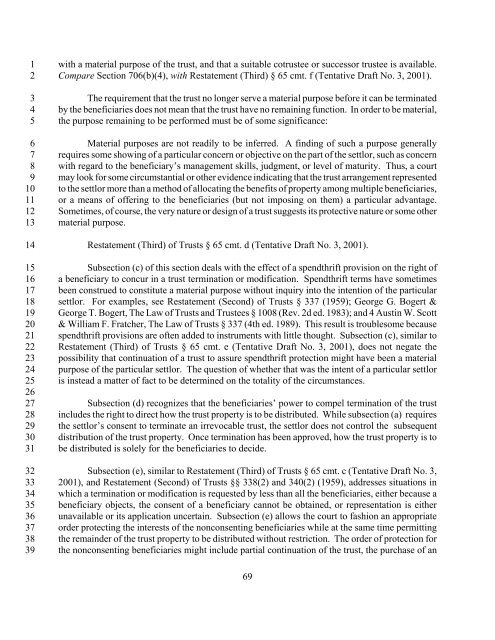uniform trust code - Kansas Judicial Branch
uniform trust code - Kansas Judicial Branch
uniform trust code - Kansas Judicial Branch
Create successful ePaper yourself
Turn your PDF publications into a flip-book with our unique Google optimized e-Paper software.
1<br />
2<br />
3<br />
4<br />
5<br />
6<br />
7<br />
8<br />
9<br />
10<br />
11<br />
12<br />
13<br />
14<br />
15<br />
16<br />
17<br />
18<br />
19<br />
20<br />
21<br />
22<br />
23<br />
24<br />
25<br />
26<br />
27<br />
28<br />
29<br />
30<br />
31<br />
32<br />
33<br />
34<br />
35<br />
36<br />
37<br />
38<br />
39<br />
with a material purpose of the <strong>trust</strong>, and that a suitable co<strong>trust</strong>ee or successor <strong>trust</strong>ee is available.<br />
Compare Section 706(b)(4), with Restatement (Third) § 65 cmt. f (Tentative Draft No. 3, 2001).<br />
The requirement that the <strong>trust</strong> no longer serve a material purpose before it can be terminated<br />
by the beneficiaries does not mean that the <strong>trust</strong> have no remaining function. In order to be material,<br />
the purpose remaining to be performed must be of some significance:<br />
Material purposes are not readily to be inferred. A finding of such a purpose generally<br />
requires some showing of a particular concern or objective on the part of the settlor, such as concern<br />
with regard to the beneficiary’s management skills, judgment, or level of maturity. Thus, a court<br />
may look for some circumstantial or other evidence indicating that the <strong>trust</strong> arrangement represented<br />
to the settlor more than a method of allocating the benefits of property among multiple beneficiaries,<br />
or a means of offering to the beneficiaries (but not imposing on them) a particular advantage.<br />
Sometimes, of course, the very nature or design of a <strong>trust</strong> suggests its protective nature or some other<br />
material purpose.<br />
Restatement (Third) of Trusts § 65 cmt. d (Tentative Draft No. 3, 2001).<br />
Subsection (c) of this section deals with the effect of a spendthrift provision on the right of<br />
a beneficiary to concur in a <strong>trust</strong> termination or modification. Spendthrift terms have sometimes<br />
been construed to constitute a material purpose without inquiry into the intention of the particular<br />
settlor. For examples, see Restatement (Second) of Trusts § 337 (1959); George G. Bogert &<br />
George T. Bogert, The Law of Trusts and Trustees § 1008 (Rev. 2d ed. 1983); and 4 Austin W. Scott<br />
& William F. Fratcher, The Law of Trusts § 337 (4th ed. 1989). This result is troublesome because<br />
spendthrift provisions are often added to instruments with little thought. Subsection (c), similar to<br />
Restatement (Third) of Trusts § 65 cmt. e (Tentative Draft No. 3, 2001), does not negate the<br />
possibility that continuation of a <strong>trust</strong> to assure spendthrift protection might have been a material<br />
purpose of the particular settlor. The question of whether that was the intent of a particular settlor<br />
is instead a matter of fact to be determined on the totality of the circumstances.<br />
Subsection (d) recognizes that the beneficiaries’ power to compel termination of the <strong>trust</strong><br />
includes the right to direct how the <strong>trust</strong> property is to be distributed. While subsection (a) requires<br />
the settlor’s consent to terminate an irrevocable <strong>trust</strong>, the settlor does not control the subsequent<br />
distribution of the <strong>trust</strong> property. Once termination has been approved, how the <strong>trust</strong> property is to<br />
be distributed is solely for the beneficiaries to decide.<br />
Subsection (e), similar to Restatement (Third) of Trusts § 65 cmt. c (Tentative Draft No. 3,<br />
2001), and Restatement (Second) of Trusts §§ 338(2) and 340(2) (1959), addresses situations in<br />
which a termination or modification is requested by less than all the beneficiaries, either because a<br />
beneficiary objects, the consent of a beneficiary cannot be obtained, or representation is either<br />
unavailable or its application uncertain. Subsection (e) allows the court to fashion an appropriate<br />
order protecting the interests of the nonconsenting beneficiaries while at the same time permitting<br />
the remainder of the <strong>trust</strong> property to be distributed without restriction. The order of protection for<br />
the nonconsenting beneficiaries might include partial continuation of the <strong>trust</strong>, the purchase of an<br />
69

















